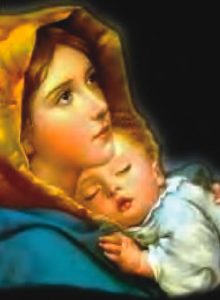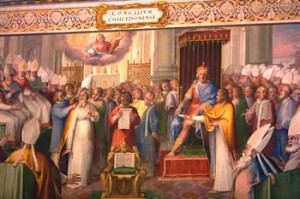Mary for Today – Mary in the Year of Faith: Mother of God.
We need to capture again the meaning of the four Marian dogmas; they are more than statements of belief. They are four major affirmations about Mary. They can be, and must be, made relevant to people in their present circumstances if they are to have meaning today. They are not all from the same period; the last two came rather late in church history.
1. Mother of God. This title is not found in the New Testament, where Mary is the mother of Jesus; it is not until Jesus is known as God, and the union of divine and human natures in the one person is recognized, that Theotokos (God bearer) is affirmed:
“If anyone does not confess that Emmanuel is truly God, and therefore that the blessed Virgin is truly Mother of God (Theotokos), for she bore according to the flesh him who is Word from God, let him be anathema.”
In recent times we have insisted more on the humanity of Jesus, rediscovering a Jesus who is very human and near to us. Christianity’s great claim is faith in a God who came and lived among us as one of us, Emmanuel, God with us. It was through Mary that the entry of God into our world was made possible. Mary leads us beyond the threshold to the very heart of Christian originality: welcoming a God who becomes human
What is Motherhood? It is much more than just a biological function; it allows one’s children to live and to grow, while respecting each individual’s freedom and responsibility. It demands an attitude of attending to life in relationships, allowing fruitful growth and activity. This is something we can all, hopefully, relate to. This is an ideal the Church must aspire to, to listen to all her children, even to those that might not always agree with her. Good mothers know this. Mary is not mother merely of the humanity of Jesus; she is not just producer of his human nature. She is human mother of the person who in his radical identity is God from God, light from light.
2. Mary and Trinity. The Gospels and Creed speak of God as Father, the first divine person. But how does the motherhood of Mary affect our sense of the Fatherhood of God? Mary at the Annunciation receives the Son of the Father, through the overshadowing of the Spirit. For this she is honoured. What was in the beginning in the Trinity, in the eternal procession of the Son from the Father, now has a new beginning in the history and fabric of the cosmos itself.
The ... role of the Father is expressed in history through the love of a mother
The eternally begotten Son is really brought forth into the world of creation, subjected to it. ‘Born of a woman’, Jesus would know poverty, live in surrender to God, enter into the risk of living for the Kingdom of God - and suffer the consequences. Having a human mother meant that the divine Son was not pretending to be human. He is the humanisation of the divine in the pain, darkness, and joy of human existence. In the womb of Mary, the world holds a divine reality within it; the Mother of Jesus is the Mother of God.
In giving and loving in her human maternal manner, Mary is the finest human expression of the love of the Father. She embodies a corrective to any excessive masculinisation of the divine. It is surely significant that the parental role of the Father is expressed in history through the love of a mother. No particular name, even one as important as ‘Father’ can be made such an absolute as to limit the infinity of God’s life and love. In the Hebrew language, the term for the ‘mercy’ or ‘compassion’ of God is rahamim; in its original form, rehem, it meant ‘the womb of a woman’. It is hardly surprising then that our God shows mother love, and Mary expresses the love of a mother.
3. The History Behind the Dogma: The definition was the outcome of the controversy over the unity of the two natures in Christ. A theological tradition centred on Antioch in Syria had come to speak of Christ’s ‘two natures’, human and divine. But Nestorius, archbishop or patriarch of Constantinople in the early 400s, got into trouble by pursuing this ‘two-natures’ Christology to an extreme, risking losing sight of their unity. Many Christians had begun to pray to Mary as Theotokos, the bearer or Mother of God. Nestorius insisted this was wrong, for Mary was only mother of the human nature. When theologians cross popular piety, then trouble breaks out.
In 451 The Council of Chalcedon declared that even after the Incarnation there were two natures, united in one person, so what is said of one nature applies to the other. One is mother of the person, not just the nature. Hence, one could indeed call Mary the Mother of God. Pope Leo I offered a formula that incorporated Nestorius’s concern for a clear distinction between the two natures in Jesus; Christ is one Person, the Divine Word, in whom two natures, human and divine, are permanently united without confusion and mixture. Chalcedon was to go on to say that Jesus was “born of the Virgin Mary …according to his humanity.”
It was this controversy that indirectly promoted Mariology in the 5th century. The definition of Theotokos was not a Marian definition, but a Christological one. It was intended to safeguard not the motherhood of Mary but the unity of Christ in one divine Person. But the Ephesus decision gave a major impetus to Marian devotion.
The January 1st Solemnity of the Mother of God, which now coincides with the octave-day of Christmas and the beginning of the New Year, was probably assigned this day because of the influence of the Byzantine Church. The restoration of the feast to January 1 in the Roman church, owes much to Pope Paul VI: “This celebration, assigned to January 1 in conformity with the ancient liturgy of the city of Rome, is meant to commemorate the part played by Mary in this mystery of salvation. It is meant also to exalt the singular dignity which this mystery brings to the ‘holy Mother . . . through whom we were found worthy . . . to receive the Author of life.’ (Marialis Cultus 1974).
References: Kathleen Coyle and Jean-Pierre Prevost


 Entries(RSS)
Entries(RSS)